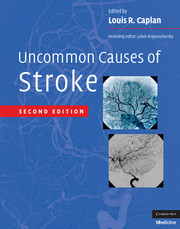Book contents
- Uncommon Causes of Stroke
- Uncommon Causes of Stroke
- Copyright page
- Contents
- List of Contributors
- Preface
- PART I: INFECTIOUS AND INFLAMMATORY CONDITIONS
- PART II: HEREDITARY AND GENETIC CONDITIONS AND MALFORMATIONS
- PART III: VASCULAR CONDITIONS OF THE EYES, EARS, AND BRAIN
- PART IV: DISORDERS INVOLVING ABNORMAL COAGULATION
- PART V: SYSTEMIC DISORDERS THAT ALSO INVOLVE THE CEREBROVASCULAR SYSTEM
- PART VI: NONINFLAMMATORY DISORDERS OF THE ARTERIAL WALL
- 60 CERVICO-CEPHALIC ARTERIAL DISSECTIONS
- 61 CEREBRAL AMYLOID ANGIOPATHIES
- 62 MOYA-MOYA SYNDROME
- 63 DILATATIVE ARTERIOPATHY (DOLICHOECTASIA)
- 64 PARADOXICAL EMBOLISM AND STROKE
- 65 FIBROMUSCULAR DYSPLASIA
- PART VII: VENOUS OCCLUSIVE CONDITIONS
- PART VIII: VASOSPASTIC CONDITIONS AND OTHER MISCELLANEOUS VASCULOPATHIES
- PART IX: OTHER MISCELLANEOUS CONDITIONS
- Index
62 - MOYA-MOYA SYNDROME
from PART VI: - NONINFLAMMATORY DISORDERS OF THE ARTERIAL WALL
Published online by Cambridge University Press: 06 January 2010
- Uncommon Causes of Stroke
- Uncommon Causes of Stroke
- Copyright page
- Contents
- List of Contributors
- Preface
- PART I: INFECTIOUS AND INFLAMMATORY CONDITIONS
- PART II: HEREDITARY AND GENETIC CONDITIONS AND MALFORMATIONS
- PART III: VASCULAR CONDITIONS OF THE EYES, EARS, AND BRAIN
- PART IV: DISORDERS INVOLVING ABNORMAL COAGULATION
- PART V: SYSTEMIC DISORDERS THAT ALSO INVOLVE THE CEREBROVASCULAR SYSTEM
- PART VI: NONINFLAMMATORY DISORDERS OF THE ARTERIAL WALL
- 60 CERVICO-CEPHALIC ARTERIAL DISSECTIONS
- 61 CEREBRAL AMYLOID ANGIOPATHIES
- 62 MOYA-MOYA SYNDROME
- 63 DILATATIVE ARTERIOPATHY (DOLICHOECTASIA)
- 64 PARADOXICAL EMBOLISM AND STROKE
- 65 FIBROMUSCULAR DYSPLASIA
- PART VII: VENOUS OCCLUSIVE CONDITIONS
- PART VIII: VASOSPASTIC CONDITIONS AND OTHER MISCELLANEOUS VASCULOPATHIES
- PART IX: OTHER MISCELLANEOUS CONDITIONS
- Index
Summary
Keywords
- Type
- Chapter
- Information
- Uncommon Causes of Stroke , pp. 465 - 478Publisher: Cambridge University PressPrint publication year: 2008
- 2
- Cited by



